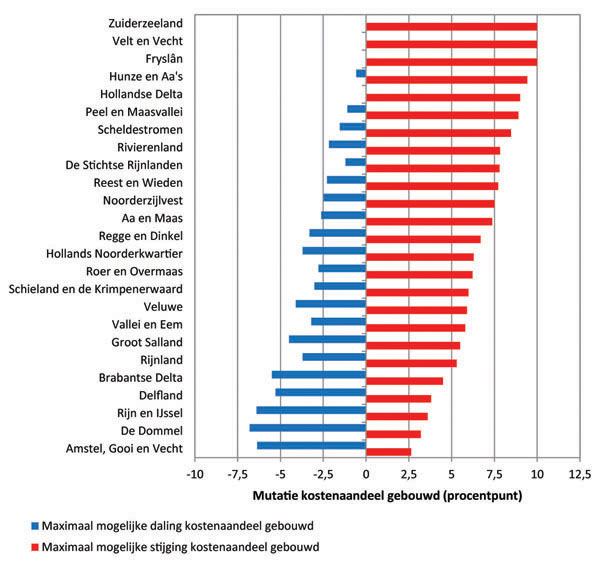Home owners to pay more for dry feet
The Association of Regional Water Authorities is considering changing the way water authorities levy taxes. The plan is intended to be implemented as of 1 January 2013. The charges will then fall even more on the shoulders of house owners. Landowners (farmers) will benefit. This has been revealed by an analysis conducted by COELO published in Weekblad Fiscaal Recht, a weekly for accountants and tax officials. COELO (the Centre for Research on Local Government Economics) is a research institute linked to the University of Groningen.
The 26 regional water authorities in the Netherlands ensure that everyone has dry feet and that the dykes are in good condition. The costs they incur are divided over households, the owners of buildings (primarily home owners) and landowners (primarily farmers). In the eyes of the law, those who profit the most from the work of the water authorities should pay a larger share of the costs. The owners of buildings currently pay about half of the costs.
The Association of Regional Water Authorities has published proposals for a new way to determine who pays what. COELO’s research reveals that the owners of buildings will then pay a larger proportion of the costs.
Who pays what
Water authorities have separate levies for households, owners of buildings and owners of land. A household living in its own home thus pays two separate water authority levies; if you also own land, then you pay three levies.
In line with current legislation, that part of the costs paid by households depends on the population density in the water authority area. The rest of the costs are divided over the home owners (built-up areas) and landowners (non-built-up areas and nature); the charges are based on the economic value of the buildings and the land.
The Association of Regional Water Authorities proposes using different criteria for landowners than for the owners of buildings. The share of the costs for landowners will then depend on the number of hectares of land per 1000 inhabitants. The owners of buildings will pay all the remaining costs. The share of the costs paid by households will remain unchanged.
Existing problems not resolved
According to the Association of Regional Water Authorities, the change is necessary because the current levy system is flawed. In some water authority areas the rate for the non-built-up area (mainly agricultural) is currently too high. However, COELO demonstrates that in these particular water authority areas, the cost share for agricultural areas will only decrease slightly if these plans are implemented.
Consequences for home owners
The second reason listed is that from now on the water authorities will have to contribute to the national government’s High Water Protection Plan. This programme is organizing the strengthening of the most important dykes, particularly those around the major rivers and along the North Sea coast. The extra costs for the water authorities will have to be passed on in a fair way. This will not be possible with the current system.
However, the proposals will lead to changes that are difficult to explain. For example, building owners will pay a greater share of the costs with less population density, and vice versa. This is not logical. If the population density is less, there are fewer houses and thus home owners benefit less from the work of the water authority. They have to pay more, though. This directly contradicts the principle where payment is dependent on interest.

Administrative freedom
The proposals give regional water authority boards more freedom to decide the share of costs to be borne by the various groups of taxpayers. At the moment, the shares of costs are mainly the result of a mathematical calculation. The Association wants to enable water authorities to make choices within the bandwidths that apply to them.
The figure shows that the owners of buildings in all water authority areas may have to pay more. In three water authority areas (Zuiderzeeland, Velt en Vecht and Fryslân), their share could be increased by up to 10 percentage points. In the Amstel, Gooi en Vecht area, at the bottom of the figure, an increase in costs for home owners of 2.6 percent is possible, but also a decrease of 6.4 percent.
Politics
Water authority boards are currently still chosen by direct election. This may also change. The Cabinet wants the municipal councils to select the boards of the water authorities. This may mean that the boards will become more politically orientated and that political preferences will determine who pays which part of the costs.
Note for the press
For more information: Dr Corine Hoeben, tel. 050 3633766, e-mail coelo rug.nl or www.coelo.nl.
C. Hoeben, 2011 Voorgestelde wijzigingen waterschapsbelastingen vergroten weeffout, Weekblad Fiscaal Recht, no. 6931 [Proposed changes to water authority levies magnify the flaw]
| Last modified: | 24 August 2021 3.29 p.m. |
More news
-
01 April 2025
UGBS Executive MBA best-rated MBA | Dutch Master's Guide 2025
According to the independent Keuzegids Masters 2025, the Executive MBA of the University of Groningen Business School is the best rated MBA in the Netherlands (both part-time and full-time programmes).
-
01 April 2025
Executive Master of M&A and Valuation accredited as joint degree with Vrije Universiteit Amsterdam
Starting 1 September, participants enrolled in the programme will receive a master's degree from both the University of Groningen and Vrije Universiteit Amsterdam upon successful completion.
-
24 March 2025
UG 28th in World's Most International Universities 2025 rankings
The University of Groningen has been ranked 28th in the World's Most International Universities 2025 by Times Higher Education. With this, the UG leaves behind institutions such as MIT and Harvard. The 28th place marks an increase of five places: in...
